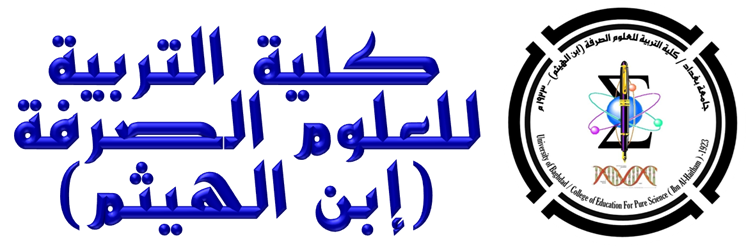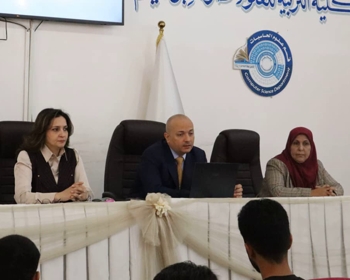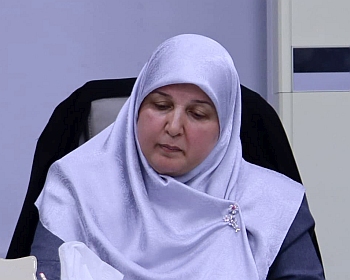ناقش قسم الكيمياء في كلية التربية للعلوم الصرفة (ابن الهيثم) رسالة الماجستير الموسومة ” تحضير وتقييم الفعالية المضادة للميكروبات لعدد جديد من المركبات الحلقية غير المتجانسة مبتدأ من حامض النيكوتين ” للطالب ” عباس حسن صخيل ” التي انجزها تحت اشراف التدريسية في القسم ” أ.م.د. رسمية محمود رميز ” ونوقشت من قبل اعضاء لجنة المناقشة المبينة اسمائهم في ما يأتي :
-
أد. ابتسام خليفة جاسم – رئيسا
-
أ.م.د. احمد متنبي عبد الله – عضوا
-
أ.م.د. رائد شاكر مصطفى – عضوا
-
أ.م.د. رسمية محمود رميز – عضوا و مشرفا
ويهدف البحث الى حضير بعض المشتقات لهذا الحامض بعدة طرق. هذا العمل يتضمن تحضير مركبات حلقية غير متجانسة مشتقة من حامض النيكوتينيك كون حامض النيكوتينيك ومشتقاته يعتبر من المركبات المهمة جدًا المستخدمة في المجال البيولوجي. لذلك تم ت
وتضمنت هذه الدراسة الاجراءات الاتية :
-
يتضمن القسم الاول تحضيرالترايازول (5) من عدة خطوات. الخطوة الاولى هي تحضير الاستر (2) بتفاعل حامض النيكوتينيك مع الميثانول بوجود حامض الكبريتيك المركز. تفاعل المركب (2) مع الهايدرازين المائي بوجود الايثانول يعطي المركب رقم (3) الذي هو حامض الهايدرازايد. الذي بدوره يتفاعل مع فنيل ايزوثايوسيانات بوجود الايثانول ليعطي المركب رقم (4) الذي هو الثايوسيميكاربازايد. الخطوة الاخيرة هي الغلق الحلقي للمركب رقم (4) بوجود قاعدة هيدروكسيد الصوديوم ليعطي المركب (5) (4-phenyl-5-(pyridin-3-yl)-4H-1,2,4-triazole-3-thiol).
-
القسم الثاني يتضمن تحضير مركبات الثايوايثر (6a,6b,6c) بتفاعل المركب رقم (5) مع هاليدات الكيل مختلفة (1- بروموبروبان, 1- بروموبيوتان وبروميد البنزايل) في وسط قاعدي بوجود الدايوكسان كمذيب.
-
القسم الثالث يتضمن تحضير مركبات السلفونيل (7a,7b,7c) بتفاعل الثايوايثر (6a,6b,6c) مع برمنكنات البوتاسيوم بوجود حامض الخليك الثلجي.
-
القسم الرابع يتضمن تحضير قواعد شف (10d,10e,10f,10g,10h) من عدة خطوات. الخطوة الاولى تحضير الحامض (8) بتفاعل الترايازول (5) مع كلوروحامض الخليك بوجود كاربونات الصوديوم كوسط قاعدي. تفاعل المركب (8) مع الثايوسيميكاربازايد بوجود كلوريد الفوسفوريل ليعطي الثايادايازول (9) الذي بدوره يتفاعل مع الالديهايد بوجود قطرات من حامض الخليك الثلجي مع الايثانول كمذيب ليعطي قواعد شف.
-
القسم الرابع يتضمن تحضير مركبات الثايوزولدين-4-ون (11d,11e,11f,11g,11h)، وذلك بتفاعل قواعد شف (10d,10e,10f,10g,10h) مع مركبتو حامض الخليك بوجود البنزين كمذيب ليعطي مركبات الثايوزولدين-4-ون.
-
تم تمييز جميع المركبات باستخدام نقاط الانصهار وأطياف FT-IR وبعضها بواسطة 1H-NMR وأطياف الكتلة.
-
تم فحص بعض هذه المركبات الجديدة للكشف عن فعاليتها المضادة للميكروبات، وذلك باستخدام أربعة أنواع من البكتيريا المرضية، وهي (Escherichia coli و(Klebsiella species (-(G و (Staphylococcus aureus و(Staphylococcus epidermidis (+(G ونوع واحد من الفطريات (Candida albicans).
Synthesis and Evaluation of Antimicrobial Activity of Some New Heterocyclic Compounds Starting from Nicotinic acid
By Abbas Hasan Sakhil Matrood
Supervised By
Assist. Prof. Dr. Rasmia Mahmood Rumez
Aim of the work
Nicotinic acid induce researchers for further developments in organic synthesis because of their biological activity.
This work includes
Synthesis of 1,2,4-triazole compound derivedfrom nicotinic acid.
The following derivatives synthesized from 1,2,4-triazole compound:
-
Synthesis of thioethers.
-
Synthesis of sulfonyl compounds.
-
Synthesis of amine compound containing thiadiazole ring.
-
Synthesis of Schiff bases.
-
Synthesis of 1,3-thiazolidin-4-one compounds.
3) Screening of biological activity for synthesized compounds against four kinds of bacteria (G+ and G-) and one kind of fungi
Abstract
Nicotinic acid, and its derivatives are very important compounds used in different field such as biological activity. Therefore some compounds have been synthesized by many methods. This work is divided into different five parts, Scheme (I)
-
The first route includes prepared of triazole (5) from several steps. The first step is prepared the ester (2) by reacted of nicotinic acid with MeOH in presence conc. H2SO4. Reaction of the ester (2) with hydrazine hydrate in EtOH to formed the acid hydrazide (3), which was reacted with phenyl isothiocyanate in ethanol as a solvent to give thiosemicarbazide (4). Finally ring closure of thiosemicarbazide (4) in the presence of NaOH(4N) to afford
triazole (4-phenyl-5-(pyridin-3-yl)-4H-1,2,4-triazole-3-thiol) (5)
. The second route includes synthesis of thioether compounds (6a-b) by reaction triazole (5) with different alkyl halide (1-bromopropane, 1-bromobutane, benzyl bromide) in alkaline medium and dioxane as a solvent
.The third route includes synthesis of sulfonyl compounds (7a-c) by reaction of thioether (6a-c) with potassium permanganate in glacial acetic acid.
.The forth route includes synthesis Schiff bases (10d-h) via several steps. The first step was prepared the acid (8)by reacted of triazole (5) with chloroacetic acid in presence of Na2CO3. Reaction of the acid (8) with thiosemicarbazide in POCl3 to formation the thiadiazole (9), which was reacted with aldehydes (benzaldehyde, 4-chlorobenzaldehyde, 4-N,N-dimethylbenzaldehyde, 4-hydroxybenzaldehyde and 4-nitrobenzaldehyde in presence of drops of glacial acetic acid with ethanol as a solvent to give Schiff bases
.The fifth route includes synthesis of thiazoldin-4-one compounds (11d-h) by reaction of Schiff bases (10d-h) with mercaptoacetic acid in benzene to give thiozoldin-4-one compounds
. All compounds were characterized by used melting points, FT-IR spectra and some of them via 1H-NMR and mass spectra
. Some of these new compounds have been screened for their antimicrobial efficiencies, using four types of pathological bacteria, the (Escherichia coli and Klebsiella species) (G-) and (Staphylococcus aureusand Staphylococcusepidermidis) (G+) and one kind of fungi (Candidaalbicans)










